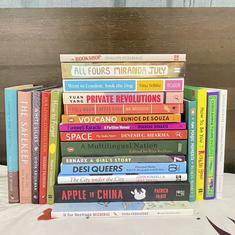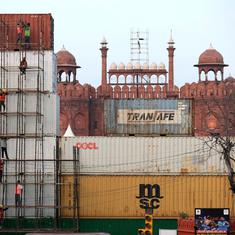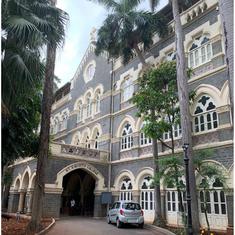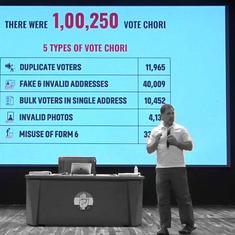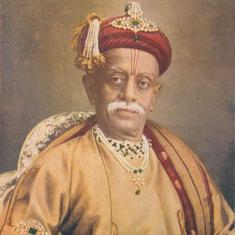On June 25 exactly 50 years ago, Prime Minister Indira Gandhi declared a national Emergency. Between 1975 and 1977, Gandhi and her son Sanjay Gandhi presided over the suspension of the fundamental rights guaranteed by the Consitution and the arrests of opposition leaders and pro-democracy activists.
June 25 will be marked as “Samvidhan Hatya Diwas” (Murder of the Constitution) by the Union government – which is ironic, given the sustained attacks on the freedom of expression on its watch.
The Emergency’s victims included filmmakers. One of the most shocking instances of censorship was the treatment accorded to Amrit Nahata’s Kissa Kursi Ka (The Tale of the Seat of Power).
Nahata’s satire about corruption and cronyism under Indira Gandhi was completed in April 1975. Not only was the film subjected to 51 cuts and then banned, Union Information and Broadcasting Minister VC Shukla had all existing prints physically destroyed.
In 1978, when the Congress had been defeated and the Janata Party took power, Nahata remade Kissa Kursi Ka. But the new version did not escape scrutiny either. Nahata’s son, Rakesh Nahata, told Scroll in 2015: “Twenty-five cuts were ordered – once people come to power, they change their position and the truth is never allowed to come out.”
Would an updated Kissa Kursi Ka about the current regime face the same fate? Films are now stored on digital copies rather than celluloid prints, making the physical destruction of films difficult, if not impossible. But there will be other ways to undermine or vapourise a story of high-level graft, a cabal operating with impunity, and the oppression visited upon ordinary citizens.
The Emergency’s fiftieth anniversary has justly inspired debates about Indira Gandhi’s legacy, the complicity of India’s elites in her tryst with tyranny and the effects of her diktats on Parliament, the judiciary and the media. All these conversations are especially relevant in this dark age of censorship for films, documentaries and streaming shows.
The Information and Broadcasting Ministry-run Central Board of Film Certification, informally – and correctly – called the censor board, is hard at work to unearth anything that could be deemed offensive, “anti-national” or, more likely, critical of the Bharatiya Janata Party-led regime. Conversely, films that parrot the government line are valourised.
The recently released Sitaare Zameen Par, starring Aamir Khan as a coach who trains basketball players with intellectual disabilities, had to remove the word “kamal”, or lotus, from a scene. The aquatic flower is the BJP’s electoral symbol.
The film was also required to carry a statement from Modi declaring that India would ensure inclusivity to physically and intellectually challenged Indians by 2047. Apart from being the centenary of Indian Independence, 2047 is the year by when the BJP government has promised to achieve “Viksit Bharat”, or a developed India.
The board has also been busy punishing filmmakers who missed the memo about according due respect to aspects of Indian culture that have been co-opted by the Hindutva movement, of which the BJP is the political arm.
The board recently stalled two Malayalam films with characters named Janaki – one of them starring Union Minister and BJP member Suresh Gopi. According to media reports, this was because Janaki is another name for Sita, the heroine of the Ramayana epic.
Attended a special screening of the film, "The Sabarmati Report," in the GMC Balayogi Auditorium, Parliament, on December 2, 2024, with the Honorable Prime Minister and other senior leaders. pic.twitter.com/bkg2aNeQdR
— Suressh Gopi (@TheSureshGopi) December 3, 2024
Janaki Vs State of Kerala, in which Gopi plays a lawyer representing a sexual assault survivor, faced objections from the board because of its title. In the upcoming Malayalam movie, Token Number, a character called Janaki Abraham will now be known as Jayanthi.
In both cases, the films were cleared by the board’s Thiruvanthapuram office – one of nine such centres in the country . But they were then sent forward to the headquarters in Mumbai. The second set of censors in Mumbai – known as the revising committee – suggested the changes, reports stated.
Until 2021, a three-tiered certification process was followed: an initial examining committee, a revising committee and the Film Certification Appellate Tribunal. The appellate tribunal served as the final court of appeal within the Central Board of Film Certification, allowing filmmakers to contest adverse rulings.
If these measures failed, filmmakers could file petitions in the courts.
In 2021, the government scrapped the tribunal, leaving filmmakers at the mercy of the censors. Only producers with deep pockets and the stomach for litigating against a muscular regime will challenge censorship in the courts.
This has been the case with Honey Trehan’s Punjab ’95, about enforced disappearances and extra-judicial killings during counterinsurgency operations in Punjab in the 1980s and 1990s. Trehan’s movie explores the excesses committed by security forces through the story of the human rights activist Jaswant Singh Khalra (Diljit Dosanjh), who vanished during an investigation that indicted senior police officials.

Punjab ’95 has endured the kind of censorship that the BJP would have denounced as draconian had it not been in power. Citing the sensitivity of the subject matter, the makers have been repeatedly asked to make cuts – over 120 so far.
The producers have appealed against the cuts in the Bombay High Court, but no decision has been reached. The required excisions include dropping references to human right abuses and the very identity of the police force. It they are carried out, Punjab ’95 will be altered beyond recognition.
The censor board has always controlled Indian cinema. Since movies cannot be shown in theatres without a censor certificate, both filmmakers and audiences have always known that everything on the screen has been granted the imprimatur of the Central Board of Film Certification.
That oversight extends to film festivals. Organisers need to clear their selections with the ministry.
Streaming platforms, on their part, follow a self-regulated code of conduct.
The BJP is hardly alone in opposing contrary viewpoints. Right from the colonial era through various Congress or non-Congress government since Independence, rulers have never been able to resist telling Indians what they may or may not watch.
Narendra Modi’s elevation as prime minister in 2014 came with the promise of sweeping out the old and ushering in the new. But censorship has only increased, whether imposed by the government or other forces.
Films or shows inspired by actual incidents, biopics on personalities who have been declared adversaries of the state, critiques of government policies, the names of characters, a saffron flag or a lotus – the government is hyper-sensitive to any expression that does not conform to its monolithic worldview.
Censorship works beyond the remit of the Central Board of Film Certification, as was evident in the cases filed against the Prime Video series Tandav (2021) and the manner in which Netflix shelved the film Tees.
While it has never been easy to pursue political projects, what is sorely lacking now is a balancing force, a neutral body that can mediate between the rampaging censor board and a filmmaker’s right to creativity.

Without bodies such as the Film Certification Appellate Tribunal and in the absence of governmental intervention when the censor board acts arbitrarily, filmmakers have learnt that survival requires them to silence themselves.
While the Kissa Kursi Ka outrage took place under Indira Gandhi, there were instances when she prevailed in battles between the censors and filmmakers, such as with MS Sathyu’s Garm Hava (1974). Sathyu’s masterpiece about a Muslim family’s travails after Partition had been held back by the censor board but cleared after Gandhi’s intervention.
If there are similar meditations taking place behind the scenes now, the public is not hearing about them.
In the old days, reports of censors taking ridiculous measures to protect the nation’s moral fibre would prompt mirth and ridicule. The replacement of a kiss with a shot of two quivering flowers being pulled together, the bowdlerisation of sexually tinged scenes or song lyrics – these restrictions continue but have been overtaken by far greater assaults on free speech.
Censorship is never funny. Yet, some filmmakers have attempted to see the light side of mind control.
In a throwaway moment in Sai Paranjpye’s Katha (1982), the lovable rapscallion Bashu (Farooque Shaikh) starts telling his neighbours a joke about “an American, a Russian and an Indian who are walking by a women’s hostel”. The joke must have been good since the men laugh uproariously, but we never hear the rest of it.
Paranjpye mutes the sound and places the word “censored” in capital letters on the screen. Her mischievous dig made it past the censor board in the 1980s. Today, it is likely that Paranjpye would have had to cut out the scene altogether.

Also read:
Ramachandra Guha: Memories of the Emergency, 50 years after authoritarianism was vanquished
What’s behind the Indira Gandhi screen revival?
In his recent book, Prabir Purkayastha recounts the crackdowns during the Emergency of 1975
